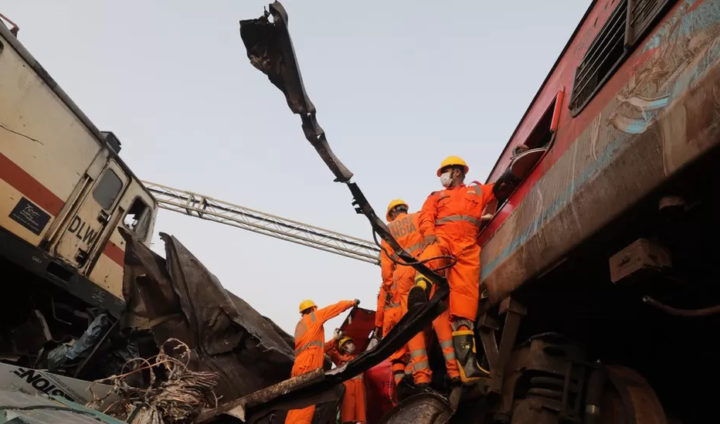A devastating train collision in India’s eastern Odisha state has claimed the lives of at least 261 individuals, leaving around 1,000 injured. The tragic incident involved three trains and has been identified as the country’s deadliest railway accident in the 21st century.
The catastrophe unfolded on Friday when one passenger train derailed and collided with an incoming train on the adjacent track. This collision subsequently struck a stationary freight train situated nearby. The crash site was subjected to an extensive recovery operation, with hundreds of emergency workers meticulously searching through the wreckage.
The precise cause of the accident remains unclear. Officials reported that multiple coaches from the Shalimar-Chennai Coromandel Express derailed in the Balasore district at approximately 19:00 local time (13:30 GMT). These derailed carriages then collided with a stationary goods train, causing several of them to end up on the opposite track.
Tragically, the situation worsened when another train, the Howrah Superfast Express en route from Yesvantpur to Howrah, crashed into the overturned carriages. Atul Karwal, the chief of the National Disaster Response Force (NDRF), described the severity of the impact, noting that the force of the collision had led to the crushing and mangling of numerous coaches.
This devastating incident ranks as the third deadliest in the history of India’s railway system. In response, over 200 ambulances, along with numerous doctors, nurses, and rescue personnel, were deployed to the scene. Sudhanshu Sarangi, director general of Odisha Fire Services, initially reported a death toll of 288.
Fortunately, all trapped and injured passengers have been successfully rescued, although the extent of their injuries remains unclear. Efforts are now underway to restore the crash site, as confirmed by the South Eastern Railway company.
Railway Minister Ashwini Vaishnaw has arrived at the accident site, and Prime Minister Narendra Modi is expected to visit the injured later in the day. Eyewitnesses and survivors have recounted chaotic scenes and the courageous actions of individuals from nearby villages who worked tirelessly to save trapped passengers.
Mukesh Pandit, who was trapped for half an hour before being rescued, recalled hearing a “thunderous sound” shortly before the carriage overturned. He expressed sorrow, revealing that while four passengers from his village survived, many others were injured or still missing, with a significant number perishing in the coach he was traveling in.
Residents from neighbouring villages were among the first to reach the accident site, initiating the rescue operation. India boasts one of the world’s largest train networks, accommodating millions of passengers daily. However, substantial improvements are needed in the country’s railway infrastructure.
During this time of year, trains can become excessively crowded, particularly with an increasing number of people traveling during school holidays. Both passenger trains involved in the crash were fully occupied, with numerous individuals also on the waiting list, according to passenger records on the Indian rail ministry website.
The worst train disaster in India’s history occurred in 1981 when an overcrowded passenger train was swept off the tracks and into a river during a cyclone in Bihar state, resulting in the tragic loss of at least 800 lives.







